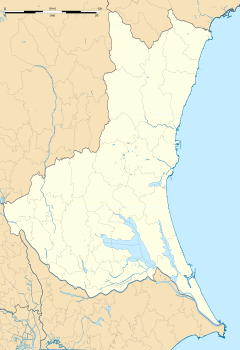Isozaki Station 磯崎駅 | |||||||||||
|---|---|---|---|---|---|---|---|---|---|---|---|
 Isozaki Station, October 2009 | |||||||||||
| General information | |||||||||||
| Location | Isozakicho, Hitachinaka-shi, Ibaraki-ken 311-1202 Japan | ||||||||||
| Coordinates | 36°22′41″N 140°37′04″E / 36.3780°N 140.6178°E | ||||||||||
| Operated by | |||||||||||
| Line(s) | ■ Minato Line | ||||||||||
| Distance | 13.3 km from Katsuta | ||||||||||
| Platforms | 1 (1 side platform) | ||||||||||
| Tracks | 1 | ||||||||||
| Other information | |||||||||||
| Status | Unstaffed | ||||||||||
| Website | Official website | ||||||||||
| History | |||||||||||
| Opened | 3 September 1924 | ||||||||||
| Passengers | |||||||||||
| FY2011 | 83 daily | ||||||||||
| Services | |||||||||||
| |||||||||||
| |||||||||||
Isozaki Station (磯崎駅, Isozaki-eki) is a passenger railway station on the Minato Line in the city of Hitachinaka, Ibaraki, Japan, operated by the third-sector railway operator Hitachinaka Seaside Railway.
Lines
[edit]Isozaki Station is served by the 14.3 km single-track Hitachinaka Seaside Railway Minato Line from Katsuta to Ajigaura, and lies 13.3 km from the starting point of the line at Katsuta.[1]
Station layout
[edit]The station is unstaffed and consists of a single curved side platform serving the single-track line.
History
[edit]Isozaki Station opened on 3 September 1924.[1]
Passenger statistics
[edit]In fiscal 2011, the station was used by an average of 83 passengers daily.[1]
Surrounding area
[edit]- Isozaki Post Office
- National Institute of Information and Communications Technology Sunspot Research Center
See also
[edit]References
[edit]External links
[edit]![]() Media related to Isozaki Station at Wikimedia Commons
Media related to Isozaki Station at Wikimedia Commons
- Hitachinaka Seaside Railway station information (in Japanese)


Well, that’s interesting to know that Psilotum nudum are known as whisk ferns. Psilotum nudum is the commoner species of the two. While the P. flaccidum is a rare species and is found in the tropical islands. Both the species are usually epiphytic in habit and grow upon tree ferns. These species may also be terrestrial and grow in humus or in the crevices of the rocks.
View the detailed Guide of Psilotum nudum: Detailed Study Of Psilotum Nudum (Whisk Fern), Classification, Anatomy, Reproduction